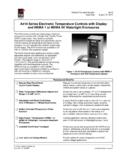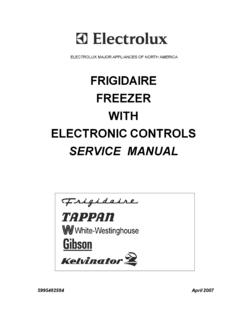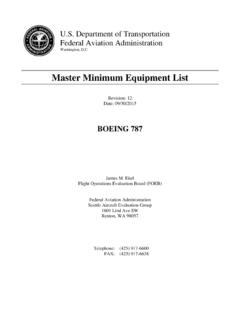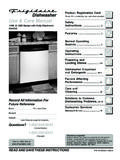Transcription of Condition Sensing Specifications - Rockwell Automation
1 Technical Data Condition Sensing Specifications Bulletin Number 808, 836, 836T, 837, 840. Topic Page Bulletin 840 Automatic Float Switches 3. Bulletin 836 Pressure Controls 5. Bulletin 836T Pressure Controls 11. Bulletin 808 Speed Switches 25. Bulletin 837 Temperature Controllers 30. Additional Resources These documents contain additional information concerning related products from Rockwell Automation . Resource Description Industrial Automation Wiring and Grounding Guidelines, publication Provides general guidelines for installing a Rockwell Automation industrial system. Product Certifications website, Provides declarations of conformity, certificates, and other certification details. You can view or download publications at To order paper copies of technical documentation, contact your local Allen-Bradley distributor or Rockwell Automation sales representative.
2 Specifications Bulletin 840 Automatic Float Switches Technical Data Conversions Technical Terms Bulletin 840 Styles A and B Float Switches are assembled for tank operation but can be easily converted to sump operation. Style A. Tank Operation When the liquid in a tank reaches a preset low switches can be changed from tank to sump operation by moving level, the float switch will start a pump to begin filling the tank. the float rod to the opposite end of the double arm lever. When the liquid level reaches a preset high level, the float switch will stop the pump. Styles B switches can be converted in either of the following ways: Sump Operation Liquid is being collected in a sump. When the Remove the lever, turn the shaft 90 counterclockwise and replace liquid reaches a preset high level, the float switch will start a pump the lever in its original position.
3 To empty the sump. When the liquid reaches a preset low level, the Remove the lever and replace 180 from the original position. float switch will stop the pump. Style D is for tank operation only. Style DS is for sump operation Operating Force Contact force required to trip the float switch. only. These switches cannot be converted. Operation depends on the type of switch, liquid, float, and float Contacts operator assembly. Bulletin 840 Float Switches have a snap action mechanism for Turbulence Waves or agitation in the liquid. Excessive turbulence quick-make and quick-break contact operation. This feature may cause improper switch operation for example, early provides high snap-through forces once the mechanism has switching or switching between operating points.
4 Traveled the required distance. See table below. Buoyancy Force supporting the float equal in magnitude to the Maximum Contact Rating per Pole weight of the displaced liquid. AC NEMA A600 DC NEMA N300. Theory of Operation Max. V Max. V. Bulletin 840 Float Switches provide automatic control for motors AC Make Break Make Break DC Make Break that pump liquids from a sump or into a tank. The switch must be 120 60 A A 7200V A 720V A . installed above the tank or sump, and the float must be in the liquid for the float switch to operate. Tank Operation: A float operator 240 30 A A 7200V A 720V A 125 A A. assembly is attached to the float switch by a rod, chain or cable. 480 15 A A 7200V A 720V A 250 A A. The float switch is actuated based on the location of the float in the 600 12 A A 7200V A 720V A.
5 Liquid. The float switch contacts are open when the float forces the operating lever to the UP position. As the liquid level falls, the float Maximum Horsepower Ratings and operating lever move downward. When the float reaches a preset low level, the float switch contacts close, activating the Single-Phase 2- or 3-Phase circuit and starting the motor. The contacts can directly activate a AC AC DC. motor or provide input for a logic system to fill the tank. As the 230- liquid level rises, the float and operating lever move upward. When 460- the float reaches a preset high level, the float switch contacts open, Style 115V 230V 115V 575V 32V 115V 230V. deactivating the circuit and stopping the motor. Sump Operation: A Tank or 1 1.
6 025 Sump operation is opposite tank operation. Sump Figure 1 B Tank or 3 2 1 1. Tank and Sump Operation Sump D Tank 2 2 3 DS Sump 2 2 3 Contact Wiring Configurations Tank Operation Sump Operation Style A (Contact Options). Motor Stop Motor Start 840-A1 840-A11 840-A12. Liquid Level Liquid Level Change Change Motor Start Motor Stop 1 - 1 (Standard) 2 2 Style B Styles D & DS. L1 L2 L3 L1 L2 L3. Temperature Range (Switch). The temperature range for the switch mechanism at +32 F (0 C) or 1 3 1 3. below is based on the absence of freezing moisture, water, or other 2 4 2 4. fluids that may solidify and impede the operation of the control . Temperature ratings are as follows: T1 T2 T1 T2. Operating: 22 +150 F ( 30 +66 C). Motor Motor Storage: 22 +200 F ( 30 +93 C).
7 Temperature Range (Float). The temperature range for the float mechanism at +32 F (0 C) or below is based on the absence of freezing moisture, water, or other fluids that may solidify and impede the operation of the control . Temperature ratings are as follows: Operating and Storage: 22 +200 F ( 30 +93 C). Rockwell Automation Publication -836-TD001A-EN-P 3. Bulletin 840 Automatic Float Switches Specifications Approximate Dimensions Approximate Dimensions and Shipping Weights Type 4. Dimensions in inches (millimeters). Dimensions are not intended to be used for manufacturing purposes. in. Conduit Hub Type 1. Mounting Bracket ( ) ( ) ( ). ( ). ( ) ( ) ( ) Dia. Mtg. ( ). Holes ( ). ( ). ( ) ( ). ( ) Dia. Mtg. Holes Style A Styles A and B.
8 Approximate Shipping Weight 4 lbs ( kg) Approximate Shipping Weight 4 lbs ( kg). ( ) ( ). ( ). ( ) ( ). ( ). Style B . Approximate Shipping Weight 3 lbs ( kg). Approx. (146). Styles D and DS . Approximate Shipping Weight 2 lbs ( kg). 4 Rockwell Automation Publication -836-TD001A-EN-P. Specifications Bulletin 836 Pressure Controls Technical Data Figure 1. Graphics to illustrate technical terms Technical Terms Adjustable operating range Total span within which the contacts can be adjusted to trip and reset. Trip setting Higher pressure setting at which value the contacts transfer from their normal state to a changed state. 100% Operating Range 100%. Adjustable Operating Randge Trip Setting Increasing Pressure psi Reset setting Lower pressure setting at which value the Maximum Occasional Maximum Line Pressure Reset Setting Surge Pressure contacts return to their normal state.
9 (Minimum Reset Minimum 75%. Operating Angle Adjustment) Differential Adjustable Maximum Adjustable differential Difference between the trip and reset Adjustable Span Differential 50%. values. (Maximum Reset Adjustment) 25%. Minimum differential When the differential is set to the lowest pressure difference between trip and reset. 0 psi Reference VAC. Maximum differential When the differential is set to the widest 30 in. Vacuum Mercury Reference pressure difference between trip and reset. Maximum occasional surge pressure Maximum surge pressure Figure 2. that can be applied to the actuator. Surges or transients can occur Positive pressure or vacuum during startup and shutdown of a machine or system. Expressed in milliseconds, complex electronic instrumentation is required to C.
10 Measure the varying amplitude, frequency, and duration of this wave form. Extreme surges that occur approximately eight times in a 24- B Trip on increasing pressure, or decreasing vacuum (toward 0 psi). contacts B to A open and hour period are negligible. contacts B to C close. A. Maximum line pressure Maximum sustained pressure that can be applied to the bellows without permanent damage. The control should not be cycled at this pressure. Reset State B to A are closed. Trip State B to C are closed. Positive pressure Any pressure more than 0 psi. See Figure 2. Trip setting Increasing pressure setting when contacts change state. Reset setting Decreasing pressure setting when contacts return to their normal state. Vacuum (negative pressure) Any pressure less than 0 psi, inches of Hg vacuum.













